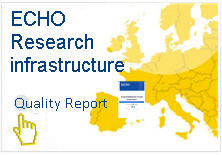Page 12
VARIATION METRICS IN ECHO
UPCOMING ENTRIES:
UPCOMING ENTRIES
SCV and EB confidence intervals
SCV and EB are meant to differentiate between systematic variation and random noise. As mentioned the more the value, the more likely the variation to be systematic. However, estimating confidence intervals would provide a more appropriate picture. This entry will describe the method on estimating confidence intervals for EB and SCV, and the results after its application to the set of ECHO indicators.
Improving SUR estimation with disease mapping techniques
SUR assumes independence across units of analysis. However, neighboured areas are likely to be dependent from each other. They usually share epidemiologic burden, frequently doctors share protocols of intervention, doctors working in a hospital frequently learnt in hospitals based in the other areas, etc. From a mathematical point of view, if this interdependence exists, it should be modelled. Disease mapping techniques could be used to modelling interdependence and, most interestingly, to determining the fraction of variation that could be attributed to the area of analysis, once interdependence is ruled out. These ideas are developed within this entry, using Besag, York and Mollie modelling.
Improving SUR estimates adding the effect of time
Systematic variation might vary as a consequence of many circumstances: the application of a specific policy, the uptake of a new guideline, the adoption of a new technology, etc. All these circumstances will likely happen differently across providers over the years. Disease mapping techniques, particularly those using CAR, can be used to modelling this phenomenon. This entry will describe the technique and provide examples of how time-dependent phenomena has modified variation over time.
False discovery rate: its effect in some ECHO examples
In some specific cases, when providers’ size or events’ prevalence is small, over-dispersion might be of relevance in the precision of estimates – false positives are more likely. If over-dispersion exists, funnel plots’ alert and alarm areas is misleading and confidence intervals should be corrected. In this entry, we will apply and analyse false discovery rate correction in several ECHO examples.





